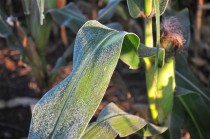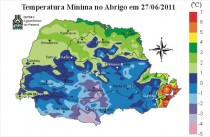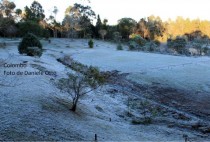By Joseph D’Aleo, CCM, WeatherBell
Last summer I gave a talk to 300 farmers in Rio Grande do Sul in southern Brazil on the July 4th US holiday at the invitation of my South American meteorological friends, Alexandre and Eugenio at the METSUL.
Now as June draws to an end, the southern parts of Brazil, a tropical country, has been stricken by the coldest weather in a decade, driving down temperatures to record-low levels and bringing snow in some areas.
In Santa Catarina, the temperature fell to 8.8 Celsius degrees below zero in the small town of Urupema on Tuesday, while in Cambara do Sul, in Rio Grande do Sul state, along the southern border, the temperature dropped to minus 6.2 degrees.
The three cities of the southern region on Tuesday also recorded record-low temperatures for the year, and the lowest temperature was monitored in Curitiba, capital of Parana state, where the temperature hovered around one degree above zero.
In Sao Paulo state, in the southeastern region, temperatures also fell to record-low levels: in Sao Paulo, the state capital, the mercury fell to 2.3 degrees, the lowest since 2003, and in Campos do Jordao, a mountainous town, the temperature dropped to 3.8 degrees below zero, the lowest since 1998.
Several towns of Rio Grande do Sul and Santa Catarina even had snow on Monday with more possible.
The Metsul map of Parana above shows the cold. Some of their posted images are below. Their blog is excellent and always filled with images but the text descriptions are in Portuguese. Tools exist on the web to translate blocks of text.
The second day of frost cause problems for grain crops in western Paraná. Both corn and wheat likely were nipped from the cold during the early hours on Tuesday.
According to local reports wheat saw more serious damage than corn. “Local agronomists estimated out 40% of corn planted in the western of the state runs the risk of losses. In volume, it is somewhere around 1 million tons. They make clear, however, that the actual size of the damage should only be known in a week.

Tuesday marked the largest cold frost of the last five years in the region of Terra Roxa. In Sao Pedro do Iguaçu, where the minimum was -2 C, frost was stronger than yesterday. As there was no wind, the freezing was faster and, therefore, about 25% of wheat, which was in the silking stage, was affected.
In Cascavel, the frost was also stronger the second night. But at first glance, the damage was not greater than those of yesterday. The biggest problem was the result of two consecutive days of intense cold, especially for late crops.
The relevance might be what happens in the United States where an early frost could nip the record late planted corn in parts of the north central and eastern Corn Belt. That is one of the ways a late planted crop has lower yields.
Meanwhile further east, South Africa is bracing for extreme cold. ALLAFRICA.COM reports:
“Zimbabweans should brace for a severe cold spell from today up to Monday next week, with overnight ground temperatures expected to drop to minus eight degrees Celsius in some places.
The Meteorological Services Department yesterday said the cold spell was a result of dry and cold continental winds sweeping across the region. The cold front would see temperatures plummeting and some areas recording severe ground frost in the morning.
“Members of the public, especially the vulnerable in such areas are urged to put on warm clothing or take necessary measures to make themselves comfortable.”
The department warned people against using braziers in their houses. The department urged people to open windows at night when using braziers and also to monitor them when there are children around.
It also urged farmers to be wary of damage to their crops, advising them to take appropriate measures. Some of the crops that are affected by cold weather are tomatoes, potatoes, wheat, flowers and vegetables.
Every year the country experience severe cold spells in winter as cold fronts move in from the south and temperatures can go as low as minus 10 degrees Celsius, the Met Department said.”
This year the cold in South America may be augmented by the Chilean volcanic aerosols which have made for some beautiful sunsets but has hampered air travel in South Amrica and as far away as Australia and New Zealand.




